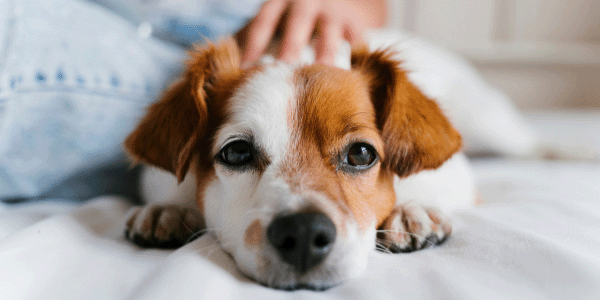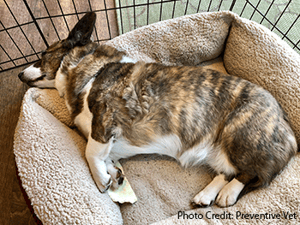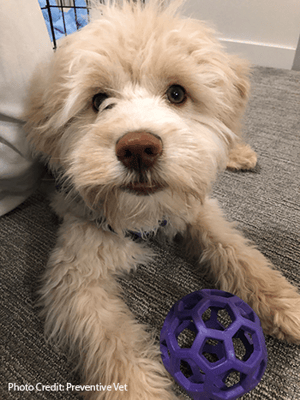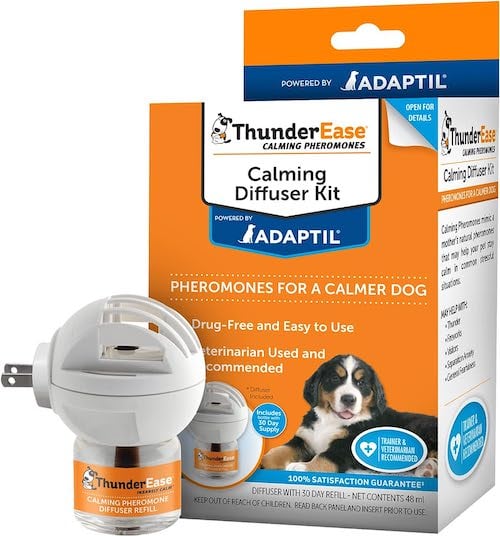 At some point in their life, your dog will need to be left alone. Unfortunately for us, we just can’t take them with us everywhere we go.
At some point in their life, your dog will need to be left alone. Unfortunately for us, we just can’t take them with us everywhere we go.
An important part of raising your puppy or welcoming a new dog into your life is to help them get used to being alone.
If your dog never learns how to stay calm when home alone for varying amounts of time, they can develop separation anxiety, which is a tough condition to treat.
It’s much easier to prevent separation anxiety than it is to fix after the fact, and teaching your puppy or dog how to be alone is the number one thing you can do for anxiety prevention.
Dogs are social creatures, and it's important that they share in daily life and get to spend time with their family. But taking the time to make sure they will feel A-OK if you need to leave them at home for a bit is essential for their mental well-being. Follow the tips below to help your pup learn that being alone is just fine and help prevent separation anxiety.
Skip Ahead
Crate Train Your Dog or Create a Long-Term Confinement Area
Crate training is a wonderful option for helping dogs relax while left alone and keeps them out of trouble. Many dogs who are properly crate trained feel more secure in their crate when left alone — it's like being in their own room with their favorite things.
You don't necessarily want to just give a new puppy or dog free access to your entire home right away, so it's important to make sure they have their own cozy area to hang out in while you're gone (or while you're home).
If you're wondering how to get started with crate training, check out Crate Training: Everything You Need to Know to learn how to make it a positive experience for both you and your dog. For puppies that are still working on potty training, creating a "Puppy Zone" is a great option to begin practicing leaving them alone.
To further create a calm crate or pen atmosphere for alone-time practice, you can also do the following:
- Plug in a dog pheromone diffuser near their pen.
- Use a white noise machine or turn on calming music while your dog is in their playpen area to mask outdoor noises that can startle them or trigger barking.
- I like to turn on DogTV for my dogs when leaving them alone to provide both calming background music and visual enrichment.
As your puppy gets older or as your new dog acclimates to their new home, you can start allowing access to larger areas of your home when they're left alone, as long as you've made sure everything is puppy-proofed!
 Create Positive Associations with Being Left Alone
Create Positive Associations with Being Left Alone
To help your dog learn that being alone is actually pretty awesome, you want to create an association between your absence and something they enjoy. For many dogs, this is something food-related, but you can also keep certain toys specifically for when you leave your dog alone, and put them away when you return. This process is called counterconditioning
When you are getting ready to leave, grab a stuffed Kong or another high-value interactive toy or food puzzle and give it to your dog. When you arrive back home, calmly remove the toy and put it away until the next time you leave. This way, your dog learns that the good stuff only comes out when you're gone.
You may want to start practicing counterconditioning without actually leaving home. Practice with just leaving the room for a minute or two, or going downstairs while your dog enjoys their treat upstairs. Work at your dog's pace.
Safety Note: Some chews and toys can be dangerous for dogs, especially without direct supervision. The Toppl by West Paw my favorite safer choice.
Read our article Potential Dangers of Popular Dog Chews to learn what to avoid when choosing your dog's toys for when they are alone.
Start Systematic Desensitization to Practice Alone Time
Beyond simply pairing your absence with a food puzzle, you should start practicing what's called systematic desensitization. This process is breaking down the entire departure routine into bite-sized pieces, practicing each step repeatedly before adding on another piece. The goal is to teach our dogs that the things we do getting ready to leave, and your leaving, is no big deal. It's creating a neutral association.
For example, you may start by simply putting on your shoes, grabbing your keys or purse, and touching the doorknob. You don't actually open the door and leave. Then you put down your keys, take off your shoes, and go back to what you were doing. You aren't giving your dog any attention throughout this process, just staying calm.
The next step might include all of the steps above, but now you open the door, step outside, close the door behind you, and then immediately re-enter. Over time, you'll add in more time before coming back into your home. A great time to practice this is when you're taking the garbage out, grabbing the mail from the mailbox, or need to do a quick grocery store run.
Watch this video to see systematic desensitization practice in action:
Keep Your Departures and Arrivals Low-Key
Don’t make a big deal about leaving them at home without you. You want your dog to learn that humans coming and going isn't a huge event. While we all love having our dogs greet us happily when we arrive home, excessive greetings (which include body slamming, seemingly uncontrollable vocalization, or greetings that last a long time) can be a sign of separation anxiety.
Arrival Tips
In my own experience, with two dogs, it's simply too crowded in the entryway of my home when they both want to greet me. I ignore them as I arrive and set my things down, take off my coat and shoes, and when they finally settle in the family room (away from the door), I go to them for a greeting and some play.
Within a few days of practicing, they caught on that the faster they settled down, the sooner I would say hi! Not only did this prevent jumping on me at the door, but it also created a much more settled arrival routine and saved me from tripping over my two Corgis underfoot.
Teaching your dog to Go to Bed when you arrive home is a similar training behavior that you can use when you arrive home.
Departure Tips
You don't want to sneak out when your dog isn't looking. For some dogs, your sudden disappearance can be scary and cause anxiety. But don't make a huge fuss about leaving. Dogs who get anxious when you leave will key into any anxiety you're feeling about leaving them alone. Keep your energy relaxed to encourage your dog to stay relaxed as well.
When I leave home and my dogs are staying behind, I do tell them goodbye, scatter some kibble for them, and always say "Be good, I'll be back" as I leave. This works as a signal that I'm leaving, is predictable, and helps them know what to expect.

Provide Lots of Exercise and Mental Enrichment
Ensuring your dog has enough exercise is important for so many behavior issues — and it isn't all about physical exercise either. Mental enrichment is just as important for your pup, and working their brain helps to tire them out just like going for a long walk. If they've gotten enough physical and mental exercise, when you leave them home alone, they'll be more likely to sleep!
Some great enrichment activities include:
- Take your dog on a "sniffari" where they get to exercise their sense of smell
- Teach your dog a new trick using clicker training
- Make a dog puzzle for your pup to solve
- Play Hide and Seek — not only does this build strong training cues, but it's a great way to exercise your dog both physically and mentally on a rainy day!
- Feed their regular meals using a puzzle bowl or a snuffle mat.
- For more enrichment ideas, check out Dog Enrichment: Toys, Games, and DIY Ideas
You can tailor enrichment activities to your dog's breed or breed mix. This not only burns energy and encourages resting when alone, but also meets instinctual needs. Take this "quiz" to get breed-specific enrichment ideas for your dog:
By taking the time to teach your dog that being alone is nothing to stress out about, you'll be saving your pup from unnecessary stress or anxiety later in life. If your dog is already exhibiting signs of separation anxiety or other problem behaviors when left alone, it's best to work with a certified dog trainer who can help you address these and work through the above steps with you.
For more tips and training exercises about preventing separation anxiety, check out this short webinar of mine that addresses the "new normal" for dogs who need to learn how to be home alone:
Have questions or want to share your story about getting your dog acclimated to alone time?
Let us know in the comments below!





